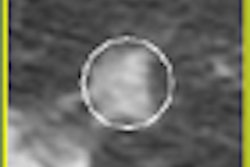Computer-aided detection (CAD) technology offers comparable performance in low-dose and standard-dose MDCT chest studies, according to research published in the British Journal of Radiology.
"This may be beneficial in reducing false-negative diagnosis in lung cancer screening, standard chest examinations, and the search for metastases," wrote a research team led by Dr. Marco Das of the RWTH Aachen University Hospital in Aachen, Germany.
Seeking to evaluate the performance of a CAD algorithm in both low-dose and full-dose MDCT studies and its impact on radiologists' performance, the research team retrospectively evaluated chest CT examinations of 77 patients for pulmonary nodules (Br J Radiol, November 2008, Vol. 81:971, pp. 841-847).
All patients had received a 16-slice MDCT study on a Somatom Sensation 16 scanner (Siemens Healthcare, Erlangen, Germany) with a standard acquisition protocol, and artificial noise was added to the raw image data to simulate a low-dose image acquisition at 10 mAseff. The newly generated raw data were transferred back to the CT scanner for a second image reconstruction using the same reconstruction parameters as the standard exam.
Data were then transferred to LungCare lung analysis software (Siemens) with a prototype LungCAD algorithm. The CAD algorithm was applied to both dose settings, and images were read both by a radiologist with six years of experience (R1) and a first-year resident (R2) with and without the software at both dose settings. The images were reviewed in consensus to set the reference standard, and the researchers then compared the sensitivity results.
From the consensus read, 677 solid pulmonary nodules were found in the 77 patients. Seven patients did not have any pulmonary nodules, while three had only one. The average nodule diameter was 5.8 mm.
At full dose, CAD found 490 of the 667 nodules, for an overall sensitivity of 73.5%. CAD identified 445 of 667 (66.7% sensitivity) nodules on the low-dose studies. The difference was not statistically significant, however (p = 0.0065).
As for the readers, R1 found 554 of 667 nodules (83% sensitivity) at full dose and 534 of 667 nodules (80.1% sensitivity) on low-dose studies. The sensitivity improvements were statistically significant (p = 0.0024).
With CAD, R1 found 623 nodules at full dose, for a sensitivity of 93.4%, and 599 nodules on the low-dose studies (89.8% sensitivity). The difference was statistically significant (p < 0.0001). For both dose settings, R1's sensitivity was increased significantly through the use of CAD (p < 0.0001).
R2 detected 450 nodules (67.5% sensitivity) at full dose and 455 nodules at low dose (68.2% sensitivity). The difference was not statistically significant (p = 0.3283). After using CAD, R2 found 593 nodules (88.9% sensitivity) at full dose and 560 nodules (84% sensitivity) at low dose. While the sensitivity difference for R2 with CAD between the dose settings was not statistically significant, the researchers found a statistically significant increase in nodule detection by R2 with the use of CAD at both settings (p < 0.0001).
Both radiologists showed a statistically significant increase in sensitivity from using CAD (p < 0.0001).
The use of low-dose MDCT with its increased image noise may increase the number of small pulmonary nodules that are missed by the radiologist, the authors noted.
"Fortunately, the bigger pulmonary nodules (> 4 mm diameter) are missed less frequently, and the detection rate between low-dose and standard-dose MDCT did not vary" with statistical significance for the two readers, the authors concluded. "The sensitivity of CAD also varies between full-dose and low-dose settings, but the combination of radiologist and CAD as a second reader can significantly improve the detection rates in low-dose and standard-dose studies, and should therefore be proposed for daily routine work."
By Erik L. Ridley
AuntMinnie.com staff writer
November 25, 2008
Related Reading
Researchers cut false positives in lung CAD, November 10, 2008
CAD detects more lung nodules but not necessarily more cancer, September 24, 2008
CAD steals show from U.S. research database, August 12, 2008
CT databases aimed at lung imaging research, August 8, 2008
CAD helps residents identify lung nodules on DR, May 20, 2008
Copyright © 2008 AuntMinnie.com

















